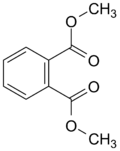Dimethyl phthalate
 |
|
| Names | |
|---|---|
|
Preferred IUPAC name
Dimethyl benzene-1,2-dicarboxylate
|
|
| Other names
Dimethyl phthalate
|
|
| Identifiers | |
|
131-11-3 |
|
| 3D model (Jmol) | Interactive image |
| ChEMBL |
ChEMBL323348 |
| ChemSpider |
13837329 |
| ECHA InfoCard | 100.004.557 |
| KEGG |
C11233 |
| PubChem | 8554 |
| UNII |
08X7F5UDJM |
|
|
|
|
| Properties | |
| C10H10O4 | |
| Molar mass | 194.184 g/mol |
| Appearance | Colorless oily liquid |
| Odor | slight aromatic odor |
| Density | 1.19 g/cm3 |
| Melting point | 2 °C (36 °F; 275 K) |
| Boiling point | 283 to 284 °C (541 to 543 °F; 556 to 557 K) |
| 0.4% (20°C) | |
| Vapor pressure | 0.01 mmHg (20°C) |
| Pharmacology | |
| P03BX02 (WHO) QP53GX02 (WHO) | |
| Hazards | |
| Flash point | 146 °C (295 °F; 419 K) |
| 460 °C (860 °F; 733 K) | |
| Explosive limits | 0.9%-? |
| Lethal dose or concentration (LD, LC): | |
|
LD50 (median dose)
|
6900 mg/kg (rat, oral) 1000 mg/kg (rabbit, oral) 2400 mg/kg (guinea pig, oral) 6800 mg/kg (rat, oral) 6800 mg/kg (mouse, oral) 4400 mg/kg (rabbit, oral) 2400 mg/kg (guinea pig, oral) |
|
LCLo (lowest published)
|
9630 mg/m3 |
| US health exposure limits (NIOSH): | |
|
PEL (Permissible)
|
TWA 5 mg/m3 |
|
REL (Recommended)
|
TWA 5 mg/m3 |
|
IDLH (Immediate danger)
|
2000 mg/m3 |
|
Except where otherwise noted, data are given for materials in their standard state (at 25 °C [77 °F], 100 kPa).
|
|
|
|
|
| Infobox references | |
Dimethyl phthalate is a organic compound with molecular formula (C2H3O2)2C6H4. The methyl ester of phthalic acid, it is a colorless liquid that is soluble in organic solvents.
Dimethyl phthalate is used as an insect repellent for mosquitoes and flies. It is also an ectoparasiticide and has many other uses, including in solid rocket propellants, and plastics. Its LD50 is 8 200 mg/kg (rats, oral).
...
Wikipedia
